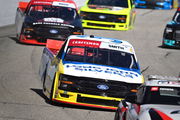

Minivans and SUVs dominated the American automobile scene after the 1980s. But before the arrival of these concepts in the American market, the most sought-after four-wheelers were station wagons. Over time, people have gradually come to favor other styles of cars that are more compact and easier to handle, or, in many cases, cars that are faster and shaped better aerodynamically.
Watch What’s Trending Now!
But cars with some history have also found many suitors in the common public, and the 1977 Mercury Bobcat Wagon might just fit the bill. The world’s greatest collector car auction house, Barrett-Jackson, brought one of these historic wagons to their latest auction in Las Vegas. And helping them auction it off is the voice of NASCAR, the legendary broadcaster Mike Joy.
ADVERTISEMENT
NASCAR legend Mike Joy lends a hand in auctioning a limited edition, Mercury Bobcat
Mike Joy is often seen at events that try to preserve a small part of American history. A connoisseur of classic and vintage cars, Joy has some of them in his personal garage as well. His love for them translated into his presence at the Barrett-Jackson auctions. He was also the broadcast narrator for the event in January in Scottsdale, Arizona. Rightfully, he has become a common name at these auctions and the A&E Network’s event broadcast.
The popular auctioneers will bring us the 1977 Mercury Bobcat Villager Wagon this year. In 1977, 47 new station wagon models were available on the market. The craze for wagons forced the manufacturers to try and make cars that suited the people’s demands without compromising on style. Ford’s Mercury Division had three variants to offer, among which the Villager Wagon would be the smallest.
ADVERTISEMENT
ADVERTISEMENT
The Bobcat Villager at the Las Vegas auctions was one of the cars that can be called a ‘veteran, if you will. With 37,000 actual miles under its belt, the 1-in-2100 wagon had seen quite the distance and still seemed like it was in perfect condition.
With a bright blue metallic finish, the car was prepared to shine on the outside while contrasting with the wooden grain on the rear and sides and matching the blue plaid interior. The Lot 107.1 car saw rapid bids from potential buyers, with the first bid going as high as $7,000. Eventually, the price went as high as $25,000 and was sold off to the lucky buyer. With a 2.3-liter straight-four base engine and the possibility of a 2.8-liter V6 engine, it had the potential to produce 100 hp and 143 lb-ft of torque.
ADVERTISEMENT
Top Stories
Greg Biffle’s $4M Prized Possession Goes Up for Sale After Tragic Crash, Leaving NASCAR Fans Heartbroken

NASCAR World Mourns as Former Watkins Glen President Michael Printup Passes Away at 60

Fox Broadcaster Pens Heartfelt Message as Veteran Announcer Quits NASCAR

Denny Hamlin Offers First Words Since Losing Beloved Father in Anniversary Fire

3x Indy 500 Champion Driver Eyes to Live 19-YO Dream With Surprise NASCAR Return

The rise of Wagons in American automobile history
Earlier, people were a bit skeptical about getting their hands on some wagons. The idea of wagons was somewhat diluted by the introduction of foreign manufacturers into the segment. One of the best examples would be Volkswagen calling their Type 2 Transporter a station wagon despite it resembling a van. Other companies, like Chrysler, Ford, and General Motors, also had a go at something like this.
A deciding factor, in this case, was that the American public had to get their wagons from a licensed dealer in the country itself. On top of that, it also had to be highway-legal in America whenever it was sold. Taking all the factors into account, 1964 would probably be the most glorious year to mass-produce a wagon in America. This is 16 years after William “Bill” France Sr. founded NASCAR. Ford UK was one of the leaders of the wagon revolution, importing British wagons like the Anglia and Cortina into the States.
ADVERTISEMENT
With a change in the decade, Japanese and Italian manufacturers began to make inroads into the American market. In the 1970s, one of the more popular four-wheelers was the Subaru 4-wheel-drive wagon, which added versatility to its arsenal while also making the vehicle safer and a reliable choice for longer drives. More Japan-based companies like Mitsubishi, Toyota, and Datsun also took the hint from the increasing sales and entered the competition.
If anything, 1977 would probably be the prime time to be a wagon owner in America. The numbers for these cars began to drop as people began to gravitate towards trucks and convertibles with a change in eras. But the wagons truly became an essential part of the day-to-day life of the common man, and now they can be classified as vintage or classic cars.
Watch This Story: Denny Hamlin Warns Bubba Wallace To Watch Out Amid Creeping Playoff Desperation
ADVERTISEMENT
ADVERTISEMENT
ADVERTISEMENT
ADVERTISEMENT

